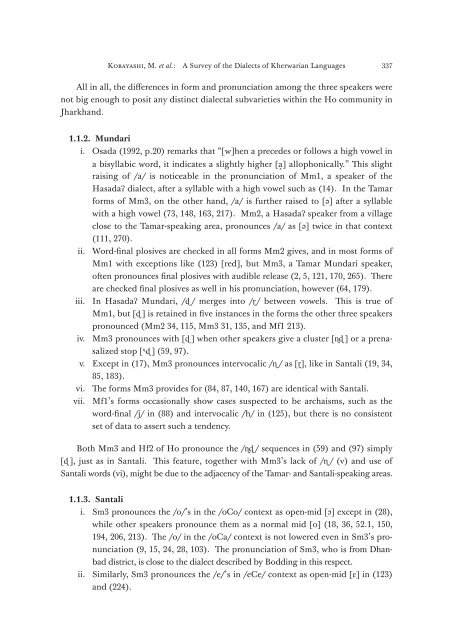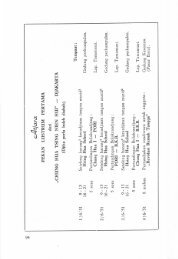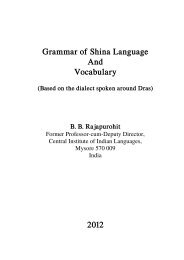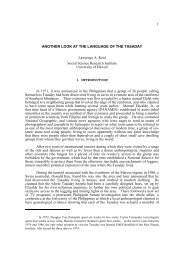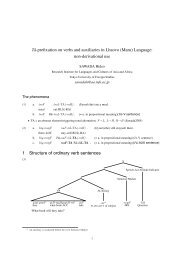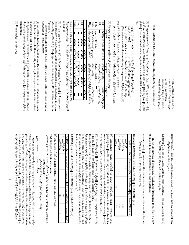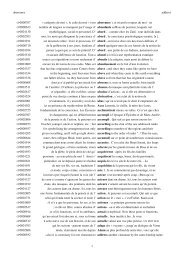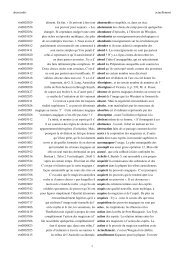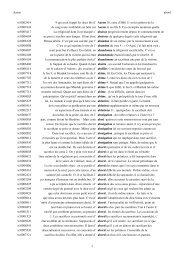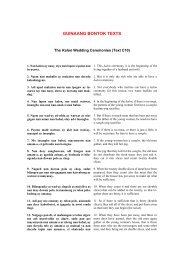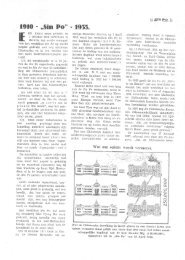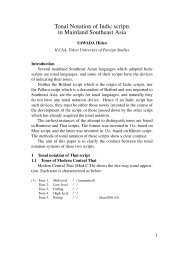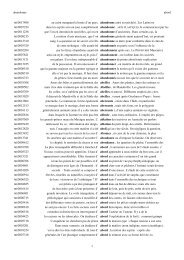ç® æ¬¡ - æ±äº¬å¤å½èªå¤§å¦ã¢ã¸ã¢ã»ã¢ããªã«è¨èªæåç 究æ
ç® æ¬¡ - æ±äº¬å¤å½èªå¤§å¦ã¢ã¸ã¢ã»ã¢ããªã«è¨èªæåç 究æ
ç® æ¬¡ - æ±äº¬å¤å½èªå¤§å¦ã¢ã¸ã¢ã»ã¢ããªã«è¨èªæåç 究æ
You also want an ePaper? Increase the reach of your titles
YUMPU automatically turns print PDFs into web optimized ePapers that Google loves.
K, M. et al.: A Survey of the Dialects of Kherwarian Languages<br />
<br />
All in all, the differences in form and pronunciation among the three speakers were<br />
not big enough to posit any distinct dialectal subvarieties within the Ho community in<br />
Jharkhand.<br />
... Mundari<br />
i. Osada (, p.) remarks that “[w]hen a precedes or follows a high vowel in<br />
a bisyllabic word, it indicates a slightly higher [a] allophonically.” is slight<br />
raising of /a/ is noticeable in the pronunciation of Mm, a speaker of the<br />
Hasada dialect, aer a syllable with a high vowel such as (). In the Tamar<br />
forms of Mm, on the other hand, /a/ is further raised to [] aer a syllable<br />
with a high vowel (, , , ). Mm, a Hasada speaker from a village<br />
close to the Tamar-speaking area, pronounces /a/ as [] twice in that context<br />
(, ).<br />
ii. Word-final plosives are checked in all forms Mm gives, and in most forms of<br />
Mm with exceptions like () [red], but Mm, a Tamar Mundari speaker,<br />
oen pronounces final plosives with audible release (, , , , ). ere<br />
are checked final plosives as well in his pronunciation, however (, ).<br />
iii. In Hasada Mundari, / / merges into // between vowels. is is true of<br />
Mm, but [ ] is retained in five instances in the forms the other three speakers<br />
pronounced (Mm , , Mm , , and Mf ).<br />
iv. Mm pronounces with [ ] when other speakers give a cluster [ ] or a prenasalized<br />
stop [ ] (, ).<br />
v. Except in (), Mm pronounces intervocalic / / as [], like in Santali (, ,<br />
, ).<br />
vi. e forms Mm provides for (, , , ) are identical with Santali.<br />
vii. Mf’s forms occasionally show cases suspected to be archaisms, such as the<br />
word-final /j/ in () and intervocalic /h/ in (), but there is no consistent<br />
set of data to assert such a tendency.<br />
Both Mm and Hf of Ho pronounce the / / sequences in () and () simply<br />
[ ], just as in Santali. is feature, together with Mm’s lack of / / (v) and use of<br />
Santali words (vi), might be due to the adjacency of the Tamar- and Santali-speaking areas.<br />
... Santali<br />
i. Sm pronounces the /o/’s in the /oCo/ context as open-mid [] except in (),<br />
while other speakers pronounce them as a normal mid [o] (, , ., ,<br />
, , ). e /o/ in the /oCa/ context is not lowered even in Sm’s pronunciation<br />
(, , , , ). e pronunciation of Sm, who is from Dhanbad<br />
district, is close to the dialect described by Bodding in this respect.<br />
ii. Similarly, Sm pronounces the /e/’s in /eCe/ context as open-mid [] in ()<br />
and ().


